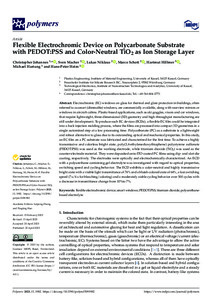| dc.date.accessioned | 2023-05-25T11:02:35Z | |
| dc.date.available | 2023-05-25T11:02:35Z | |
| dc.date.issued | 2023-04-22 | |
| dc.identifier | doi:10.17170/kobra-202305198056 | |
| dc.identifier.uri | http://hdl.handle.net/123456789/14756 | |
| dc.description.sponsorship | Gefördert durch den Publikationsfonds der Universität Kassel | ger |
| dc.language.iso | eng | eng |
| dc.rights | Namensnennung 4.0 International | * |
| dc.rights.uri | http://creativecommons.org/licenses/by/4.0/ | * |
| dc.subject | flexible electrochromic device | eng |
| dc.subject | smart windows | eng |
| dc.subject | PEDOT:PSS | eng |
| dc.subject | titanium dioxide | eng |
| dc.subject | polyurethane-based electrolyte | eng |
| dc.subject.ddc | 620 | |
| dc.title | Flexible Electrochromic Device on Polycarbonate Substrate with PEDOT:PSS and Color-Neutral TiO2 as Ion Storage Layer | eng |
| dc.type | Aufsatz | |
| dcterms.abstract | Electrochromic (EC) windows on glass for thermal and glare protection in buildings, often referred to as smart (dimmable) windows, are commercially available, along with rearview mirrors or windows in aircraft cabins. Plastic-based applications, such as ski goggles, visors and car windows, that require lightweight, three-dimensional (3D) geometry and high-throughput manufacturing are still under development. To produce such EC devices (ECDs), a flexible EC film could be integrated into a back injection molding process, where the films are processed into compact 3D geometries in a single automized step at a low processing time. Polycarbonate (PC) as a substrate is a lightweight and robust alternative to glass due to its outstanding optical and mechanical properties. In this study, an EC film on a PC substrate was fabricated and characterized for the first time. To achieve a highly transmissive and colorless bright state, poly(3,4-ethylenedioxythiophene) polystyrene sulfonate (PEDOT:PSS) was used as the working electrode, while titanium dioxide (TiO2) was used as the counter electrode material. They were deposited onto ITO-coated PC films using dip- and slot-die coating, respectively. The electrodes were optically and electrochemically characterized. An ECD with a polyurethane containing gel electrolyte was investigated with regard to optical properties, switching speed and cycling behavior. The ECD exhibits a color-neutral and highly transmissive bright state with a visible light transmittance of 74% and a bluish-colored state of 64%, a fast switching speed (7 s/4 s for bleaching/coloring) and a moderately stable cycling behavior over 500 cycles with a decrease in transmittance change from 10%to 7%. | eng |
| dcterms.accessRights | open access | |
| dcterms.creator | Johannes, Christopher | |
| dcterms.creator | Macher, Sven | |
| dcterms.creator | Niklaus, Lukas | |
| dcterms.creator | Schott, Marco | |
| dcterms.creator | Hillmer, Hartmut | |
| dcterms.creator | Hartung, Michael | |
| dcterms.creator | Heim, Hans-Peter | |
| dc.relation.doi | doi:10.3390/polym15091982 | |
| dc.subject.swd | Elektrochromes Material | ger |
| dc.subject.swd | Fenster | ger |
| dc.subject.swd | Polyethylendioxythiophen <Poly-3,4-Ethylendioxythiophen> | ger |
| dc.subject.swd | Titandioxid | ger |
| dc.subject.swd | Elektrolyt | ger |
| dc.subject.swd | Polycarbonate | ger |
| dc.type.version | publishedVersion | |
| dcterms.source.identifier | eissn:2073-4360 | |
| dcterms.source.issue | Issue 9 | |
| dcterms.source.journal | Polymers | eng |
| dcterms.source.volume | Volume 15 | |
| kup.iskup | false | |
| dcterms.source.articlenumber | 1982 | |


